page 22
~ The Study of Threes ~
http://threesology.org
| 1 | 2 | 3 | 4 | 5 | 6 |
| 7 | 8 | 9 | 10 | 11 | 12 |
| 13 | 14 | 15 | 16 | 17 | 18 |
| 19 | 20 | 21 | 22 | 23 |
The following reference was culled from another website regarding the number 3 or have "three" as a focus, though other labeling may be used. Please give all respective authors their due credits. Links are provided as supplied in context.
 |
||||
|
|
|
|
|
|
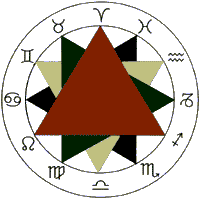 |
In the whole world shines the Triad, over which the Monad rules. This order is the beginning of all section; For the mind of the Father said, that all things be cut Into three. (The Oracles of Zoroaster) |
Classical philosophy tells us that number three, the Triad, is a sacred number symbolising harmony, balance, completion and fulfillment. Three is the number of the triangle, and in mystical geometry and numerology both shape and number are used to represent the natural cycle of life; that is:
 |
|
Hence, number three is the number of completion, the 'whole', the beginning, middle and end of all things. All world religions are underpinned by this ancient belief; the Christian faith speaks of the Holy Trinity being the Father (universal parent from which we emerge), son (separate life as an individual) and Holy Ghost (universal soul to which we return). Holy trinities are not peculiar to Christianity; they are part of a very widespread and ancient tradition that recognised the power of number three. The Babylonians, for example, were particularly fond of classifying their gods into triads - that of Anu, Enlil and Ea being their most notable.
In astrology the beneficial associations of number three are evident in the interpretation of the trine aspect as a relationship that denotes harmony and fulfillment. They are also evident in the use of triplicities - the connection of signs that share a common agreement - and in the determination of planetary dignity through the use of triplicity rulers.
| Trigonal relationship of signs |
The 1st century astrologer Manilius wrote in his Astronomica that triangles inscribed within the circle of the zodiac group the signs into four sets of triplicities:
Where the circle of the zodiac's rightward wheel is bounded, a line runs out into three equal lengths and joins itself at limits which are mutually extreme; the signs which the line strikes are called trigonal, because an angle is thrice formed and is assigned to three signs separated from each other by three intervening signs. The Ram beholds at equal distance the two signs of the Lion and the Archer rising on opposite sides of him; the signs of the Virgin and the Bull are in harmony with Capricorn ... [1]
Triplicities were identified because of the harmonious relationship inherent in the shape created by their relationship to each other. The association between triplicities and elements arose from this but was not explicitly stated by early astrologers such as Ptolemy and his contemporaries. Though humours were essential to their work, there was no characterisation of say, Aquarius as an 'air-sign' or Scorpio as a 'water-sign'. In Hellenistic astrology, the recognition of the triplicity lay in the fact that it facilitates agreement between the signs that are associated through the shape and symbolism of the triangle. Consequently any planets that are placed within those signs are able to create an harmonious blend of energies.
| Ancient Assignment of Triplicity Rulers |
Each group of triplicities has its own set of planetary rulers. Lilly mentioned two for each triplicity - a day ruler and a night-time ruler - but originally there were three rulers for each sect. The list of triplicity rulers given by Dariot in the 16th century [2] is a more faithful reproduction of the earlier scheme used by the likes of Vettius Valens and Dorotheus in the classical period. In this system each triplicity has two rulers which exchange priority according to whether the chart is diurnal or nocturnal, plus a third ruler which is common to both sects. 'Know the lords of the triplicities of the signs' said Dorotheus, 'the lords of the triplicity of Aries by day are the Sun, then Jupiter, then Saturn. By night Jupiter, then the Sun, then Saturn'. [3]
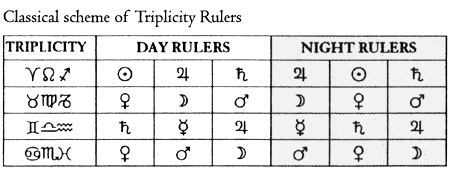
The selection of triplicity rulers is dependent upon the correct alignment between planetary nature and sect; in other words, a diurnal triplicity could not be governed by a nocturnal planet and vice-versa. The argument is that nocturnal planets have a very different quality to diurnal ones, and that beneficial influences are increased when planets are located in a suitably compatible environment.
One point that confuses many people about planetary sects is that Mars - notably hot and dry - is aligned to the nocturnal sect which is cold and moist. If this seems confusing, remember that it was done to moderate the natural excess of Mars and not to strengthen it. Mars is damaging through its excess of heat and is better able to produce a beneficial influence when its natural qualities are harnessed than when they are promoted, as they would be if Mars were aligned with the diurnal sect. The same goes for Saturn, which is assigned to the warmth of the diurnal sect in order to moderate its naturally excessive coldness. [4] The sects to which the planets are most suited are:

| Breakdown of Rulership Logic |
Given that the Aries triplicity comprises Aries, Leo and Sagittarius, we might expect that it would be ruled by Mars, Sun and Jupiter, the respective rulers of these signs. However, Mars cannot be accepted as a ruler because it is assigned to the nocturnal sect and this triplicity is diurnal. Saturn is therefore substituted for Mars and acts as a co-ruler for the triplicity both day and night.
The Capricorn triplicity comprises Taurus, Virgo and Capricorn - three nocturnal signs. It might be argued that Mercury should take a part in ruling this triplicity because of its dominion over Virgo, but the intrinsically dry nature of Mercury makes it uncomfortable in the moist nocturnal triplicity, so the Moon, who delights under such conditions, especially at night, is substituted. Saturn, the diurnal ruler of Capricorn is also substituted for Mars which is better placed in the nocturnal sect.
The Libra triplicity is diurnal, comprising Gemini, Libra and Aquarius. Saturn takes precedence during the day, because it both rules Aquarius and is exalted in Libra, while Mercury, ruler of Gemini takes precedence at night. Venus, the ruler of Libra is dismissed because it is a nocturnal planet and so needs to be substituted for a diurnal one. The options are Jupiter or the Sun. Since the Sun is essentially debilitated in two of the three signs that make up this triplicity, Jupiter is the natural choice.
Finally, the Cancer triplicity is nocturnal, comprising Cancer, Scorpio and Pisces. The rulers of these signs are the Moon, Mars and Jupiter, but because Jupiter is diurnal it is substituted for nocturnal Venus.
The rulers of each triplicity are thus established as follows:
- Aries trigon - Sun, Jupiter, Saturn
- Cancer trigon - Venus, Mars, Moon
- Libra trigon - Saturn, Mercury, Jupiter
- Capricorn trigon - Venus, Moon, Mars
Most early astrologers used all three planets, rotating their priority by day and night, but many later ones, including Lilly, chose to use only the principal rulers. Perhaps they rejected the convoluted logic that lay behind the definition of sect, or perhaps they were confused by Ptolemy who appears to mention only two rulers for the Aries and Capricorn triplicities, yet explicitly mentions three rulers for the others.
| Use of the Three-Rulership scheme |
The 3-rulership scheme maintains a natural symbolic significance to the principles encapsulated by the Triad, particularly in allowing the three rulers to be used as significators of the beginning, middle and end of any project. Although astrologers make poor use of them today, it would be difficult to overstate the importance of triplicities in classical astrology, especially in this kind of symbolic overview of any situation. Dorotheus, writing in the 1st century, says of them:
I tell you that everything which is decided or indicated is from the lords of the triplicities, and as for everything of afflictions and distress which reaches the people of the world and the totality of men, the lords of the triplicities decide it. [5]
In his Carmen Astrologicum, Dorotheus shows how the triplicities can be used to interpret almost any aspect of life. For example, in a diurnal nativity the Sun and its three triplicity rulers indicate the condition of the father, while the Moon and its triplicity rulers will tell you about the life of the Mother. [6] If you want to know about a man's general relationship with women, look to the triplicity of Venus:
If the first of the lords of Venus's triplicity is in a good place and the second in a bad place, then this condition in the matter of women is good in the beginning of his age, and in the last it is bad, because the first of the lords of Venus's triplicity indicates the first years, the second indicates the middle years and the third indicates the end of life.
The following charts are taken from ancient texts to demonstrate the use of triplicity rulers in practice. For the record, I have experimented with this technique on many examples of my own and have so far been impressed with the results.
| Practical Examples |
In judging the overall fortune and condition of life, Dorotheus advises us to consider the Sun and the rulers of its triplicity in a diurnal nativity and the Moon and the rulers of its triplicity in a nocturnal nativity.
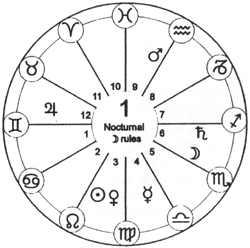 |
Chart 1 is a nocturnal nativity so it is ruled by the Moon. Because the Moon is placed in Scorpio its triplicity rulers (by night) are Mars, then Venus, then the Moon itself. All three triplicity rulers are cadent, which Dorotheus took to indicate that the native would always be poor and needy and would struggle to meet his daily needs. |
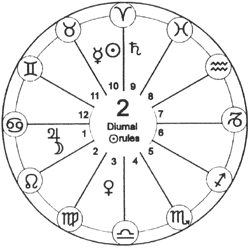 |
Chart 2 is a diurnal nativity with the Sun in Aries. The Sun rules the Aries triplicity by day with Jupiter as the secondary ruler. Both these planets are strong by being angular in their signs of exaltation. Dorotheus took this to mean that the native would 'receive the praise of noble and wealthy men'. Saturn, the 3rd ruler of the Sun's triplicity is cadent but it is in the sign of Jupiter and is aspected by trine to its dispositor, so it indicates mixed circumstances. There is still a certain amount of good fortune. |
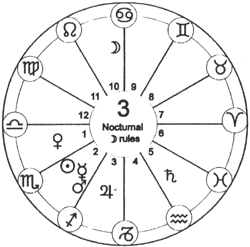 |
Chart 3 comes from the files of Vettius Valens. It is the nativity of a 'distinguished' person born in 50 AD. The nativity is nocturnal so recourse is to the Moon and its triplicity rulers. Because the Moon is in Cancer by night the triplicity rulers are Mars, then Venus, then the Moon. Valens says that it is evident that the nativity is a notable one because all the triplicity rulers are in their own signs and two of them are angular. |
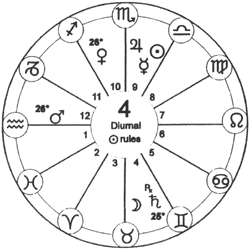 |
Chart 4 demonstrates the use of triplicity rulers as significators for the beginning, middle and end of life. The chart is taken from the work of Rhetorius and is claimed to be the nativity of the poet Pamprepius, born in 440 BC. It is a diurnal nativity and Rhetorius points out that Saturn is the first triplicity ruler of both the leading luminary and the ascendant. Because Saturn is retrograde, in aspect of Mars and in opposition to its dispositor (Venus), Rhetorius asks 'how could he not have had a hard first period of life?' [7] |
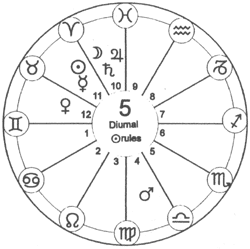 |
The final example is again taken from Dorotheus's Carmen Astrologicum. The nativity is diurnal and the Sun in Aries. The Sun is therefore the principal ruler of its own triplicity, well placed in the 11th house in its sign of exaltation. Jupiter, the 2nd triplicity ruler is also well placed in the 10th house in its own sign while Saturn, the 3rd triplicity ruler, is accidentally dignified in the midheaven. This man will 'abound in gold and silver' says Dorotheus; but he also adds a warning:- 'his end is evil because the lord of [the cardinal] under the earth, from which the matter of the end and the situation of death are known, is Venus, and Venus in this nativity is cadent in the sign of calamity [12th house]'. |
| Notes & References: |
|
First published in
The Traditional Astrologer
issue 6: Autumn 1994.
http://www.skyscript.co.uk/deb/ta6.html
|
Links and Resources Understanding Planetary Dignity and Debility Detailed article on the basis of dignity and its meaning in judgment Dignities Quiz Playing the interactive quiz '20 Questions on Dignities & Debilities' will test and reinforce your knowledge of dignity rulerships View Ptolemy's Table of Essential Dignities View Lilly's Table to Examine the Strength &: Debility of Each Planet |
— Terms and Conditions — All rights on all text and images reserved. Reproduction by any means is not permitted without the express agreement of Deborah Houlding or in the case of articles by guest astrologers, the copyright owner indicated. |
Updated Posting: Saturday, 17-June-2007... 4:29 PM
Newest Update: Sunday, 04- August -2017... 1:19 PM
Herb O. Buckland
herbobuckland@hotmail.com